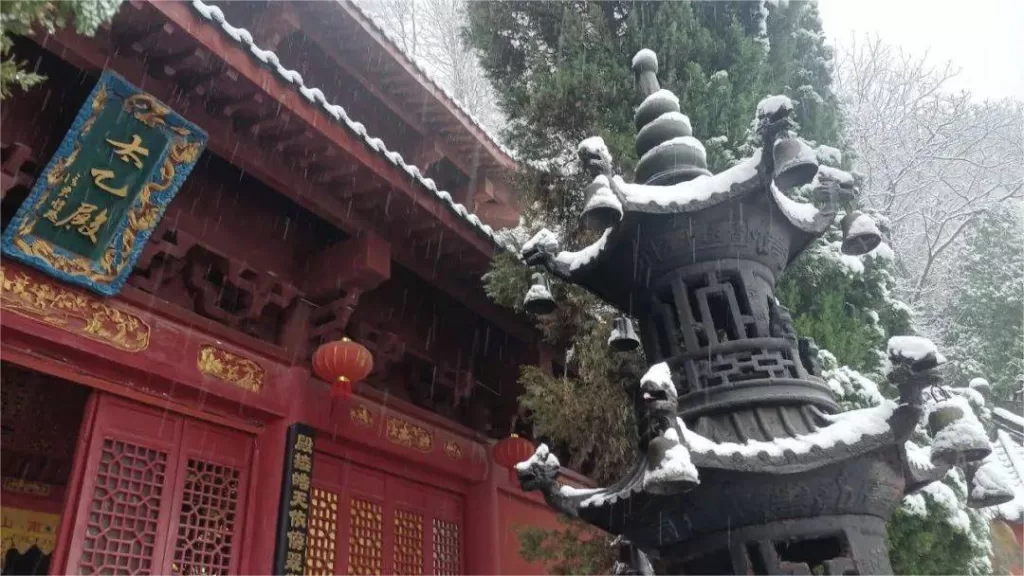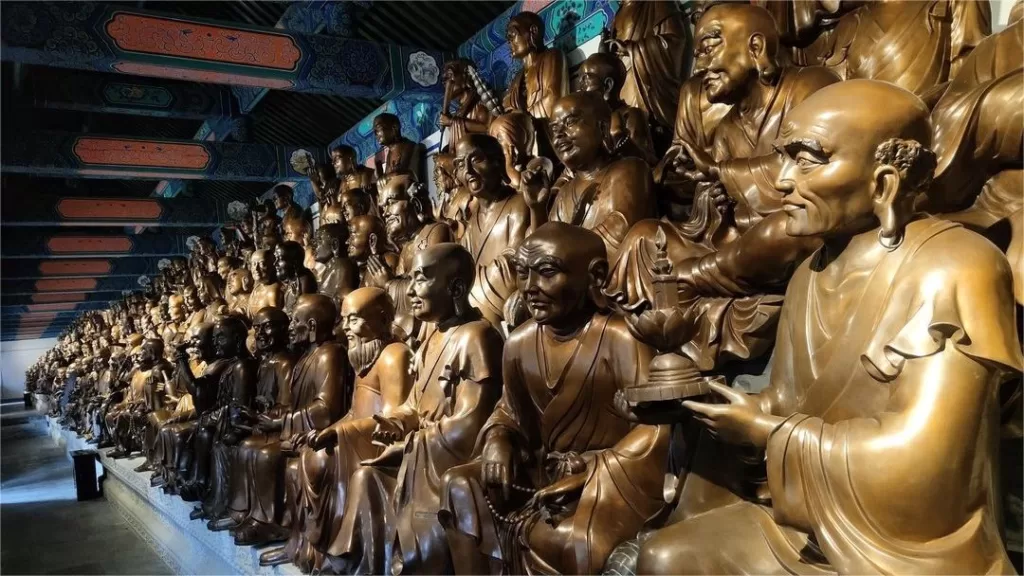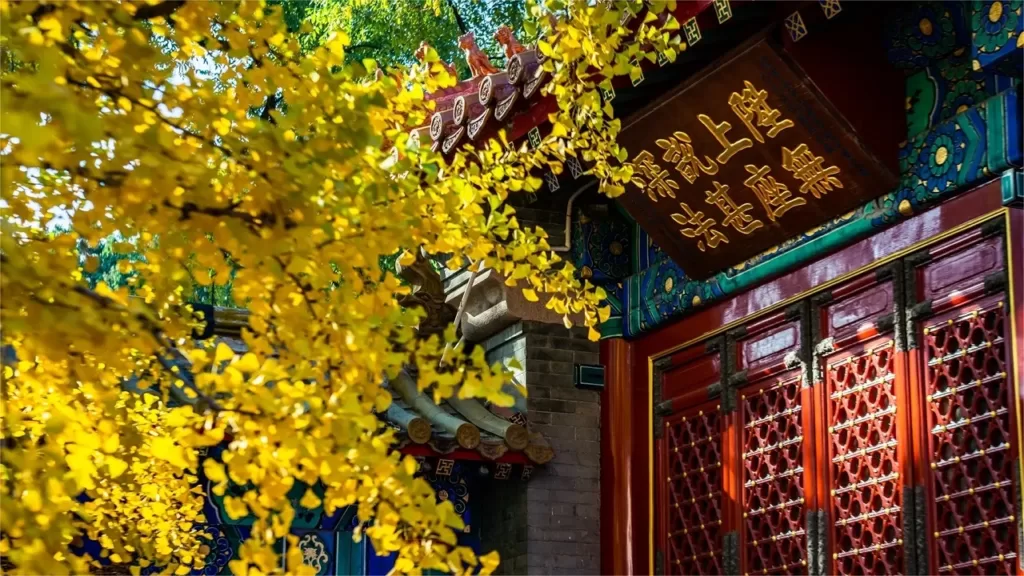Hongluo Temple (红螺寺), located in Huairou District, Beijing, has a rich history dating back to the Eastern Jin Dynasty in the year 338 AD. It is considered the birthplace of Buddhism in northern China and is the largest Buddhist monastery in the region, often referred to as the “Putuo of the North” in comparison to the famous Mount Putuo in the south. Throughout the ages, Hongluo Temple has been a sacred destination for Buddhist worship and prayer in the Beijing area. The temple grounds are adorned with ancient towering trees, and its seasonal attractions include blooming flowers in spring, a cool retreat in summer, the vibrant hues of red leaves in autumn, and the scenic beauty of pine trees, plum blossoms, and bamboo in winter.
Hongluo Temple is divided into two main sections: the main temple area and the Guanyin Temple at the summit. The main temple area, including the Mahavira Hall and the Five Hundred Arhats Forest are not extensive, with a circumference of a few hundred meters, making it possible to explore on foot in about an hour. In addition to Buddhist rituals, visitors can appreciate the abundant plant life within the temple, with three notable scenes – “Imperial Bamboo Grove,” “Male and Female Ginkgo Trees,” and “Wisteria on Pine Trees”.
After exploring the temple, visitors can ascend the hillside along a small path, climbing approximately a thousand steps. Along the way, different statues of the Bodhisattva Avalokiteshvara (Guanyin) appear, each with unique features, making the ascent both spiritually enriching and visually engaging. The Guanyin Temple at the mountain top is believed to be particularly efficacious for those seeking blessings for childbirth, attracting many worshippers. From the summit, one can enjoy panoramic views of the rolling mountains and towns below, offering a sense of expansiveness and tranquility.
For those who may find the climb challenging, there is an alternative option to descend using the scenic area’s slide, covering a distance of approximately 800 meters and providing a direct route to the Guanyin Temple at the mountain top.
Table of Contents
- Basic Information
- Location and Transportation
- Highlights of Hongluo Temple
- Map and Recommended Route
- Vlog about Hongluo Temple
- Useful Tips Summarized from Reviews
- Other Temples in Beijing
Basic Information
| Website | https://www.hongluosi.com/ |
| Estimated length of Tour | 3 hours |
| Ticket Price | 54 RMB |
| Opening Hours | 8.00 – 17.00 (1st May – 30th September) 8.30 – 16.00 (1st October – 30th April the next year) |
| Telephone Number | 0086-010-60681518 |
Location and Transportation
Hongluo Temple is located in the northern part of Beijing, China, at the foot of Hongluo Mountain. Situated in the Huairou District, it offers a serene and picturesque setting away from the bustling city center. To get to Hongluo Temple from Beijing, you can choose the following ways:
Bus: Take bus 916 at Dongzhimen Station (东直门车站) and transfer to H57 at Huairou Bus Station (怀柔汽车站) to get to the temple. This option takes about 2.5 hours and costs 15 RMB.
Express Coach: There are express coaches to Hongluo Temple at Liuli Bridge Station (六里桥客运站) on subway line 6 and Sihui Station (四惠客运站) on subway line 1. But they are only available on Saturday, Sunday, and national holidays. The one-way trip costs 30 RMB, and the return costs 40 RMB.
Highlights of Hongluo Temple
Main Hall (Mahavira Hall)

The Main Hall, located north of the Hall of Heavenly Kings, is the largest building in Hongluo Temple. It features a five-bay structure with a surrounding veranda and a hipped roof, supported by intricately crafted brackets (dougong) under the eaves. The hall stands on a high platform with a moon terrace in front. Inside the hall, the front section enshrines statues of Shakyamuni Buddha, the Medicine Buddha, and Amitabha Buddha, flanked by the Eighteen Arhats on the east and west sides. Behind the Shakyamuni statue is a statue of Avalokitesvara (Guanyin) Bodhisattva
Tianqi Bell
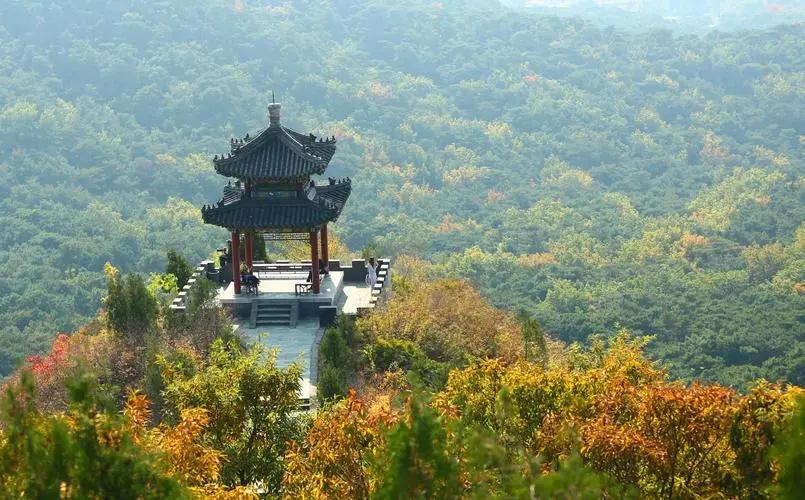
Hanging on the east side of the Main Hall is the Tianqi Bell, bestowed by the emperor in the fifth year of the Tianqi reign (1625) during the Ming Dynasty. The bell stands 171.6 cm tall, with a diameter of 103.6 cm and a weight of approximately one ton. Made of bronze, it features a double dragon handle and a lotus petal cap with the Eight Trigrams around the base. The surface of the bell is inscribed with the entire Diamond Sutra, including the chanting rituals, merits of recitation, names of the twenty Yakshas, Four Heavenly Kings, the Five Fruits, Six Supernatural Powers of Arhats, Bodhisattvas, and Buddhas. In total, the bell bears 6,406 raised characters, with an additional 89 characters inscribed by Emperor Zhu Youxiao of the Ming Dynasty and the bell’s creator, the eunuch official Wang Tiqian. The names of four craftsmen are also cast inside the bell’s inner wall, adding ten more characters, making a total of 6,505 characters, all in regular script.
Related Legends
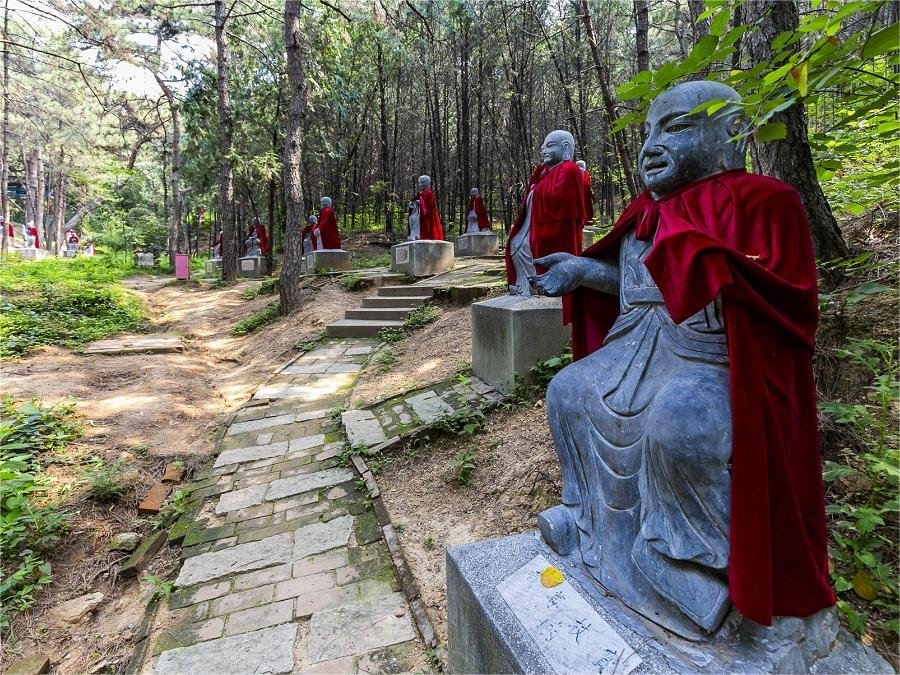
Legend has it that two princesses of the Jade Emperor descended to Earth together. They arrived at a large mountain where the landscape was beautiful, with lush ancient trees and a serene temple hidden among the greenery. The temple resonated with the rhythmic sound of wooden fish and the clear chanting of monks. Although it wasn’t a celestial paradise, it surpassed one in beauty, deeply touching the hearts of the two princesses.
The princesses wished to stay here forever, so they transformed into two giant red snails and lived in the lake in front of the temple. During the day, they took human form and joined the monks in worship and chanting. At night, the two princesses reverted to their snail forms, emitting radiant red light that illuminated the temple and the mountain slopes. They used their divine powers to secretly protect the temple and the local people. From that time on, the area enjoyed favorable weather, flourishing forests, and abundant harvests, and the people were deeply grateful for the blessings of the red snail fairies.
Later, the Jade Emperor summoned them back to the Heavenly Palace. In memory of these two red snail fairies, the mountain to the north of the temple was named Hongluo Mountain, and the lake to the south was called Hongluo Lake. Consequently, the temple itself came to be known as Hongluo Temple.
Cultural Festivals and Ceremonies
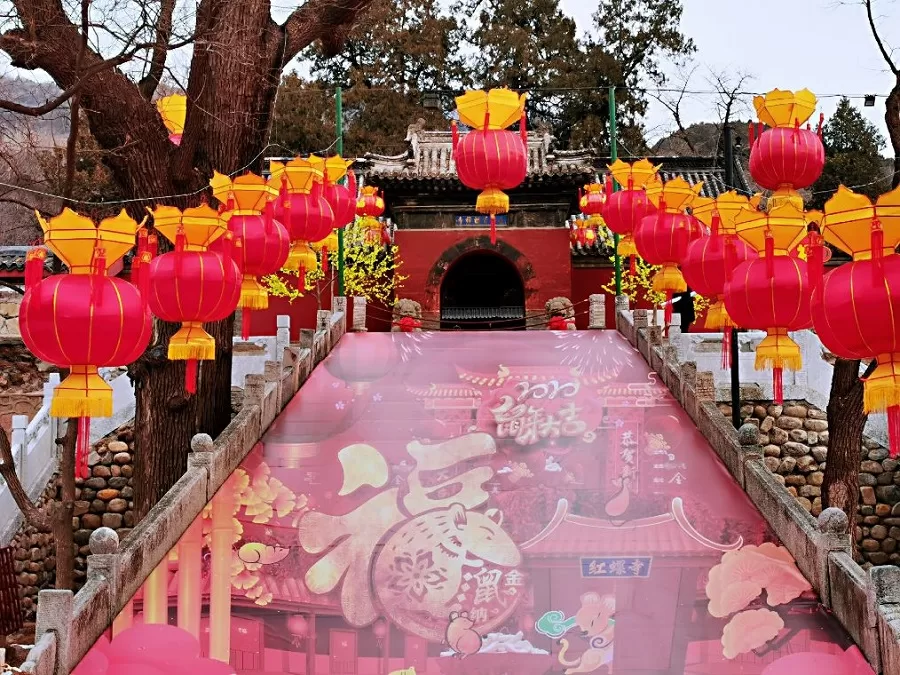
Hongluo Temple in Beijing is renowned for its vibrant cultural festivals and religious ceremonies, creating a captivating atmosphere throughout the year. Visitors have the opportunity to witness traditional rituals, performances, and spiritual practices that showcase the deep-rooted cultural heritage of China. Colorful festivals, such as the Lantern Festival and the Buddha’s Birthday Celebration, bring the temple grounds to life with ornate decorations, lively processions, and cultural performances. These events offer a unique insight into the customs and traditions associated with Buddhism, providing visitors with an immersive experience that celebrates the spiritual and cultural significance of Hongluo Temple.
Meditation and Spiritual Retreat

Hongluo Temple in Beijing provides a serene sanctuary for meditation and spiritual retreat. Amidst the tranquil surroundings of nature, visitors can find solace and inner peace. The temple offers meditation sessions and retreat programs, inviting individuals to embark on a journey of self-reflection and mindfulness. Whether experienced practitioners or beginners, everyone can benefit from the serene ambiance and guidance provided by the temple’s resident monks. The peaceful atmosphere, coupled with the breathtaking views of Hongluo Mountain, creates an ideal environment for contemplation, introspection, and spiritual rejuvenation.
Map and Recommended Route
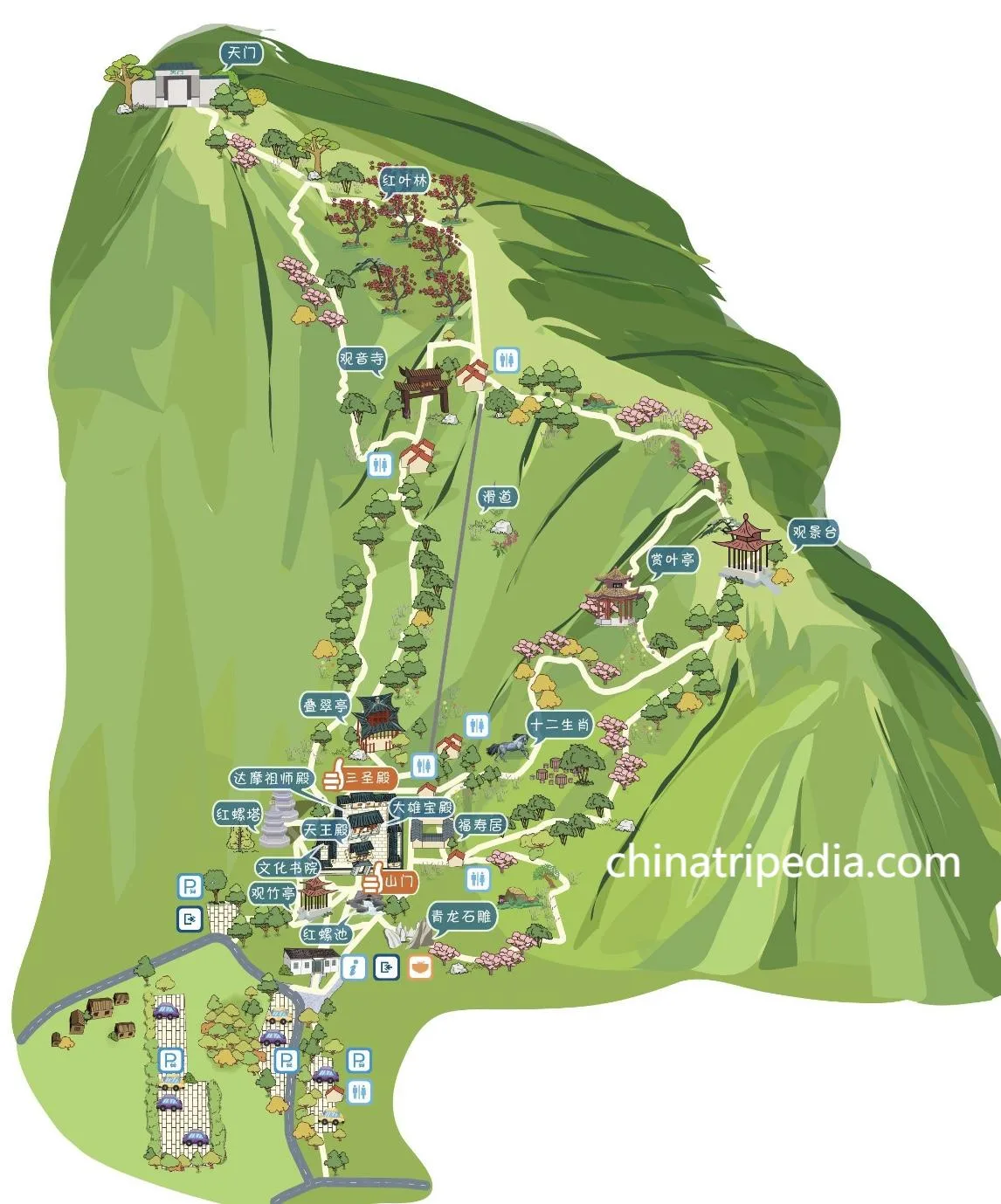
Upon entering the scenic area, you’ll first encounter the ancient temple area, which consists of three main halls and six side halls. In front of each hall, you can take three incense sticks for free to pray to the Buddha. This area tends to be quite busy, as it is said to be particularly effective for praying for marriage and children.
After exploring the temple area, exit through the back door of the last hall and start ascending the mountain. The path behind the back door is a bit narrow. Take the left path up Guanyin Road, where you will find 33 statues of Guanyin along the way. As you continue to pray at each statue, you will soon reach Guanyin Temple, which also has three main halls where you can take three incense sticks for free to make offerings.
After leaving this area (the exit is on the right side of the last hall), continue walking until you reach a crossroad. From here, you can climb up to the Heavenly Gate, which involves many steps. The sign indicates that the straight-line distance is 400 meters. Once you reach the highest point, the distant views are quite impressive.
For those tired from the climb, there is a slide available for descending, but it can get crowded during holidays. We chose to descend using the route on the right side of the map. The scenery along this path is very beautiful. There is a viewing platform along the way, offering stunning views of layers of mountains covered in trees behind you and the picturesque Yanqi Lake in front.
Vlog about Hongluo Temple
Useful Tips Summarized from Reviews
Entertainment Activities:
- Bell Ringing: Experience the tradition of bell ringing for a small fee of 2 yuan per attempt within the ancient temple area.
- Throwing Coins for Good Luck: Exchange 20 yuan for 10 copper coins to toss into designated holes for good luck. This activity is believed to bring wealth and fortune.
Food and Beverage Options: There are no restaurants within the temple grounds. However, there is a place selling water, cold drinks, and grilled sausages near the Guanyin Hall. It’s advisable to bring your own food and water. Alternatively, plan your visit around meal times and dine at one of the many restaurants outside the temple.
Descending the Mountain: Consider taking the slide-like small car down the mountain. While not overly fast, it offers a refreshing and scenic descent. You may experience a slight sensation of weightlessness during turns and descents. This option is particularly enjoyable in summer, providing cool breezes and panoramic views of the surrounding landscape.
Return Journey: If time permits, you can extend your trip by visiting Yanqi Lake before heading back. You can conveniently catch a train from Huairou North Station back to downtown Beijing.


